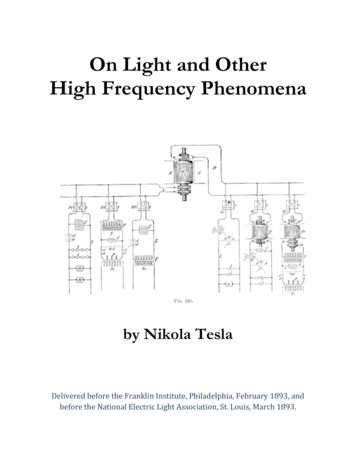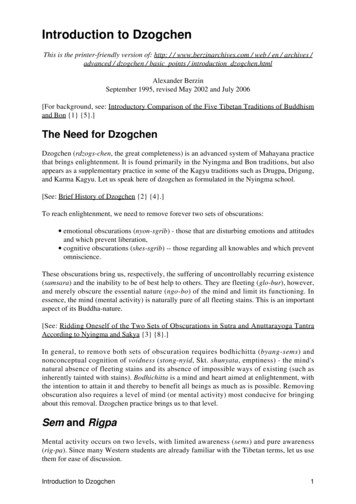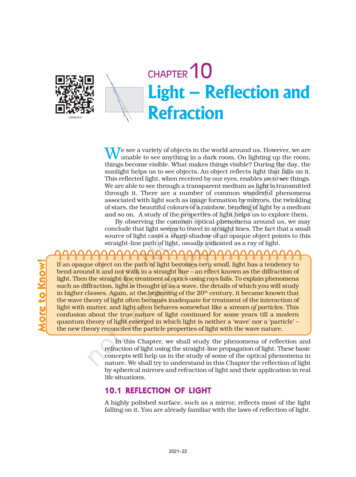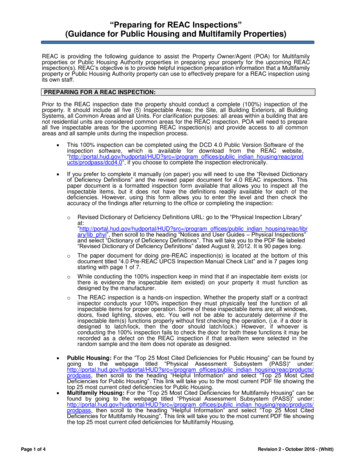
Transcription
On Light and OtherHigh Frequency Phenomenaby Nikola TeslaDelivered before the Franklin Institute, Philadelphia, February 1893, andbefore the National Electric Light Association, St. Louis, March 1893.
NewsletterBefore doing anything else, make sure to sign up for the free EnergyTimes newsletter a: Energy Times Newsletter.You'll also get whatever Free offers are there!2
Table of ContentsForeword.page4Introductory - Some Thoughts on the Eye .page9On the Apparatus and Method of Conversion.page 18On Phenomena Produced by Electrostatic Force .page 33On Current or Dynamic Electricity Phenomena.page 43Impedance Phenomena.page 52On Electrical Resonance .page 55On the Light Phenomena Produced by High-Frequency Currents of HighPotential and General Remarks Relating to the Subject . page 65Energy Science & Technology Conference .page 873
ForewordTesla's Method of Conversion is an important concept that any "free energy"enthusiast should understand.If a refrigerator or other appliance is running that has an electric motor, ithas electromagnetic coils that get charged up. If the power is instantlyturned off, these magnetic fields collapse very fast and induce a very highvoltage and low to no current spike. These high voltage spikes can shootdown your electrical wiring and destroy electronics that are connected tothe same line.There are different forms of protection built into different power supplies,etc. that can turn your electronics off before the high voltage spike candestroy them. The conventional thought on these high voltage spikes or"inductive spikes" is that they're useless and need to be grounded out butTesla knew better.Telsa's Method of Conversion involved creating these spikes on purpose bycharging up inductors (electromagnetic coils) and then interrupting thepower supply to cause the magnetic fields to collapse. These collapsingfields as described above are very fast and cause the coil to produce aninductive spike.These spikes are also a form of negative or cold energy; the quality of themis very different than normal electricity. Tesla would capture theseinductive spikes in a capacitor (storage medium) and then instantlydischarge this capacitor in a single IMPULSE into a low impedance loadsuch as the primary input of a transformer coil. The transformer can thenstep that voltage up to even higher voltages.4
Tesla obviously explains himself better than anyone else in this paper onthis concept. However, how it applies to the average free energy enthusiastis that the most replicated project in this entire field that uses Tesla'sMethod of Conversion is undoubtedly John Bedini's School Girl Energizerknown as the Bedini SG.5
What the diagram above shows is that when the magnets on the wheelcause the transistor switch to turn on, the inductor or power coil is turnedon. This creates an electromagnetic field and when the magnet moves awayand the transistor turns off, the magnetic field collapses very fast. Thiscauses the coil to produce a very high voltage inductive spike.What is not shown in this basic diagram is that a single diode can beconnected to the coil to give the spike a place to go and that is directly toanother battery (low impedance load) to charge it up.Conventional thinking is that these spikes cannot charge a battery sincethere is virtually no current to them, but thousands of people around theworld have proven this idea to be false. Not only do the batteries chargeup, they charge up faster, stronger and last longer and old worn outbatteries can even be rejuvenated.Another popular version of the Bedini SG is to capture these spikes into acapacitor just like Tesla and then discharge this in an IMPULSE directly toa low impedance load, which of course is a battery.Thousands if not tens of thousands of people all around the world havereplicated this at some level based all on John Bedini sharing amazing anddeceptively simple circuits that teaches us all the basics of real Teslatechnology.The results have been beyond astounding to the point that this was thegenesis of the world's first commercially available battery charger andrejuvenation product line based on Tesla's Method of Conversion. All theitems are hand built to order personally by John Bedini and his amazinghand-picked team in Idaho, USA.The first charger known as the Tesla Charger 2A12 was the flagshipproduct and is a 2 amp 12 volt charger-rejuvenator that drastically extends6
the life of batteries and can even bring back many from the dead that noother charging technology can touch.The first generation of the Tesla Charger 2A12 delivered the inductivespikes directly to batteries. However, since this is charging the batterieswith negative energy, they were no longer able to be charged withconventional battery chargers.The successive generations all charged capacitors, which were thendischarged in an IMPULSE to the battery and this converted the negativeenergy to a positive energy so the batteries were still compatible with allother conventional chargers.John Bedini is a humanitarian and wants others to be able to learn abouthis technologies. Since his circuits are protected by worldwide patents andyou can't build these for commercial use, he has given everyone theblessing to build his Bedini SG energizers for personal use in order to learnfrom them.7
You'll be able to learn Tesla's Method of Conversion, achieve some veryinteresting results and learn things about electricity you may never havethought possible. Even if you don't have a background in electricalengineering, you can build a Bedini SG and get it to work and just have funand you can take satisfaction in knowing that you are contributing toTesla's legacy!To a Brighter Future,Aaron Murakami (February 2015)LEARN MORE - VISIT THESE WEBSITESTesla Chargers - http://teslachargers.comBedini SG - The Complete Handbook Series: Bedini SGEnergy Science & Technology Conference - Come meet the REAL TeslaMasters - http://energyscienceconference.com8
IntroductorySome Thoughts on the EyeWhen we look at the world around us, on Nature, we are impressed withits beauty and grandeur. Each thing we perceive, though it may bevanishingly small, is in itself a world, that is, like the whole of the universe,matter and force governed by law,—a world, the contemplation of whichfills us with feelings of wonder and irresistibly urges us to ceaselessthought and inquiry. But in all this vast world, of all objects our sensesreveal to us, the most marvelous, the most appealing to our imagination,appears no doubt a highly developed organism, a thinking being. If thereis anything fitted to make us admire Nature’s handiwork, it is certainly thisinconceivable structure, which performs its innumerable motions ofobedience to external influence. To understand its workings, to get adeeper insight into this Nature’s masterpiece, has ever been for thinkers afascinating aim, and after many centuries of arduous research men havearrived at a fair understanding of the functions of its organs and senses.Again, in all the perfect harmony of its parts, of the parts which constitutethe material or tangible of our being, of all its organs and senses, the eye isthe most wonderful. It is the most precious, the most indispensable of ourperceptive or directive organs, it is the great gateway through which allknowledge enters the mind. Of all our organs, it is the one, which is in themost intimate relation with that which we call intellect. So intimate is thisrelation, that it is often said, the very soul shows itself in the eye.It can be taken as a fact, which the theory of the action of the eye implies,that for each external impression, that is, for each image produced uponthe retina, the ends of the visual nerves, concerned in the conveyance of theimpression to the mind, must be under a peculiar stress or in a vibratorystate, It now does not seem improbable that, when by the power of thoughtan image is evoked, a distinct reflex action, no matter how weak, is exertedupon certain ends of the visual nerves, and therefore upon the retina. Will9
it ever be within human power to analyse the condition of the retina whendisturbed by thought or reflex action, by the help of some optical or othermeans of such sensitiveness, that a clear idea of its state might be gained atany time? If this were possible, then the problem of reading one’s thoughtswith precision, like the characters of an open book, might be much easier tosolve than many problems belonging to the domain of positive physicalscience, in the solution of which many, if not the majority: of scientific menimplicitly believe. Helmholtz has shown that the fundi of the eye arethemselves, luminous, and he was able to see, in total darkness, themovement of his arm by the light of his own eyes. This is one of the mostremarkable experiments recorded in the history of science, and probablyonly a few men could satisfactorily repeat it, for it is very likely, that theluminosity of the eyes is associated with uncommon activity of the brainand great imaginative power. It is fluorescence of brain action, as it were.Another fact having a bearing on this subject which has probably beennoted by many, since it is stated in popular expressions, but which I cannotrecollect to have found chronicled as a positive result of observation is, thatat times, when a sudden idea or image presents itself to the intellect, thereis a distinct and sometimes painful sensation of luminosity produced in theeye, observable even in broad daylight.The saying then, that the soul shows itself in the eye, is deeply founded,and we feel that it expresses a great truth. It has a profound meaning evenfor one who, like a poet or artist, only following; his inborn instinct or lovefor Nature, finds delight in aimless thoughts and in the merecontemplation of natural phenomena, but a still more profound meaningfor one who, in the spirit of positive scientific investigation, seeks toascertain the causes of the effects. It is principally the natural philosopher,the physicist, for whom the eye is the subject of the most intenseadmiration.Two facts about the eye must forcibly impress the mind of the physicist,notwithstanding he may think or say that it is an imperfect opticalinstrument, forgetting, that the very conception of that which is perfect orseems so to him, has been gained through this same instrument. First, theeye is, as far as our positive knowledge goes, the only organ which is10
directly affected by that subtle medium, which as science teaches us, mustfill all space; secondly, it is the most sensitive of our organs, incomparablymore sensitive to external impressions than any other.The organ of hearing implies the impact of ponderable bodies, the organ ofsmell the transference of detached material particles, and the organs oftaste. and of touch or force, the direct contact, or at least some interferenceof ponderable matter, and this is true even in those instances of animalorganisms, in which some of these organs are developed to a degree oftruly marvelous perfection. This being so, it seems wonderful that theorgan of sight solely should be capable of being stirred by that, which allour other organs are powerless to detect, yet which plays an essential partin all natural phenomena, which transmits all energy and sustains allmotion and, that most intricate of all, life, but which has properties suchthat even a scientifically trained mind cannot help drawing a distinctionbetween it and all that is called matter. Considering merely this, and thefact that the eye, by its marvelous power, widens our otherwise verynarrow range of perception far beyond the limits of the small world whichis our own, to embrace myriads of other worlds, suns and stars in theinfinite depths of the universe, would make it justifiable to assert, that it isan organ of a higher order. Its performances are beyond comprehension.Nature as far as we know never produced anything more wonderful. Wecan get barely a faint idea of its prodigious power by analyzing what itdoes and by comparing. When ether waves impinge upon the humanbody, they produce the sensations of warmth or cold, pleasure or pain, orperhaps other sensations of which we are not aware, and any degree orintensity of these sensations, which degrees are infinite in number, hencean infinite number of distinct sensations. But our sense of touch, or oursense of force, cannot reveal to us these differences in degree or intensity,unless they are very great. Now we can readily conceive how an organism,such as the human, in the eternal process of evolution, or morephilosophically speaking, adaptation to Nature, being constrained to theuse of only the sense of touch or force, for instance, might develop thissense to such a degree of sensitiveness or perfection, that it would becapable of distinguishing the minutest differences in the temperature of abody even at some distance, to a hundredth, or thousandth, or millionth11
part of a degree. Yet, even this apparently impossible performance wouldnot begin to compare with that of the eye, which is capable ofdistinguishing and conveying to the mind in a single instant innumerablepeculiarities of the body, be it in form, or color, or other respects. Thispower of the eye rests upon two thins, namely, the rectilinear propagationof the disturbance by which it is effected, and upon its sensitiveness. Tosay that the eye is sensitive is not saying anything. Compared with it, allother organs are monstrously crude. The organ of smell which guides adog on the trail of a deer, the organ of touch or force which guides aninsect in its wanderings, the organ of hearing, which is affected by theslightest disturbances of the air, are sensitive organs, to be sure, but whatare they compared with the human eye! No doubt it responds to thefaintest echoes or reverberations of the medium; no doubt, it brings ustidings from other worlds, infinitely remote, but in a language we cannotas yet always understand. And why not? Because we live in a mediumfilled with air and other gases, vapors and a dense mass of solid particlesflying about. These play an important part in many phenomena; theyfritter away the energy of the vibrations before they can reach the eye; theytoo, are the carriers of germs of destruction, they get into our lungs andother organs, clog up the channels and imperceptibly, yet inevitably, arrestthe stream of life. Could we but do away with all ponderable matter in theline of sight of the telescope, it would reveal to us undreamt of marvels.Even the unaided eye, I think; would he capable of distinguishing in thepure medium, small objects at distances measured probably by hundredsor perhaps thousands of miles.But there is something else about the eye which impresses us still morethan these wonderful features which we observed, viewing it from thestandpoint of a physicist, merely as an optical instrument,—somethingwhich appeals to us more than its marvelous faculty of being directlyaffected by the vibrations of the medium, without interference of grossmatter, and more than its inconceivable sensitiveness and discerningpower. It is its significance in the processes of life. No matter what one’sviews on nature and life may be, he must stand amazed when, for the firsttime in his, thoughts, he realizes the importance of the eye in the physicalprocesses and mental performances of the human organism. And how12
could it be otherwise, when he realizes, that the eye is the means throughwhich the human race has acquired the entire knowledge it possesses, thatit controls all our motions, more still, and our actions.There is no way of acquiring knowledge except through the eye. What isthe foundation of all philosophical systems of ancient and modern times, infact, of all the philosophy of men? I am I think; I think, therefore I am. Buthow could I think and how would I know that I exist, if I had not the eye?For knowledge involve.; consciousness; consciousness involves ideas,conceptions; conceptions involve pictures or images, and images the senseof vision, and therefore the organ of sight. But how about blind men, willbe asked? Yes, a blind man may depict in magnificent poems, forms andscenes from real life, from a world he physically does not see. A blind manmay touch the keys of an instrument with unerring precision, may modelthe fastest boat, may discover and invent, calculate and construct, may dostill greater wonders—but all the blind men who have done such thinkshave descended from those who had seeing eyes. Nature may reach thesame result in many ways. Like a wave in the physical world, in theinfinite ocean of the medium which pervades all, so in the world oforganism:, in life, an impulse started proceeds onward, at times, may be,with the speed of light, at times, again, so slowly that for ages and ages itseems to stay; passing through processes of a complexity inconceivable tomen, but in ;ill its forms, in all its stages, its energy. ever and everintegrally present. A single ray of light from a distant star falling upon theeye of a tyrant in by-gone times, may have altered the course of his life,may have changed the destiny of nations, may have transformed thesurface of the globe, so intricate, so inconceivably complex are theprocesses in Nature. In no way can we get such an overwhelming idea ofthe grandeur of Nature, as when we consider, that in accordance with thelaw of the conservation of energy, throughout the infinite, the forces are ina perfect balance, and hence the energy of a single thought may determinethe motion of a Universe. It is not necessary that every individual, noteven that every generation or many generations, should have the physicalinstrument of sight, in order to be able to form images and to think, that is,form ideas or conceptions; but sometime or other, during the process ofevolution, the eye certainly must have existed, else thought, as we13
understand it, would be impossible; else conceptions, like spirit, intellect,mind, call it as you may, could not exist. It is conceivable, that in someother world, in some other beings, the eye is replaced by a different organ,equally or more perfect, but these beings cannot be men.Now what prompts us all to voluntary motions and actions of any kind?Again the eye. If I am conscious of the motion, I must have an idea orconception, that is, an image, therefore the eye. If I am not preciselyconscious of the motion, it is, because the images are vague or indistinct,being blurred by the superimposition of many. But when I perform themotion, does the impulse which prompts me to the action come fromwithin or from without? The greatest physicists have not disdained toendeavour to answer this and similar questions and have at tunesabandoned themselves to the delights of pure and unrestrained thought.Such questions are generally considered not to belong to the realm ofpositive physical science, but will before long be annexed to its domain.Helmholtz has probably thought more on life than any modern scientist.Lord Kelvin expressed his belief that life’s process is electrical and thatthere is a force inherent to the organism and determining its motions. justas much as I am convinced of any physical truth I am convinced that themotive impulse must come from the outside. For, consider the lowestorganism we know—and there are probably many lower ones—anaggregation of a few cells only. If it is capable of voluntary motion it canperform an infinite number of motions, all definite and precise. But now amechanism consisting of a finite number of parts and few at that, cannotperform are infinite number of definite motions, hence the impulses whichgovern its movements must come from the environment. So, the atom, theulterior element of the Universe’s structure, is tossed about in spaceeternally, a play to external influences, like a boat in a troubled sea. Were itto stop its motion it would die: hatter at rest, if such a thin; could exist,would be matter dead. Death of matter! Never has a sentence of deeperphilosophical meaning been uttered. This is the way in which Prof. Dewarforcibly expresses it in the description of his admirable experiments, inwhich liquid oxygen is handled as one handles water, and air at ordinarypressure is made to condense and even to solidify by the intense cold:Experiments, which serve to illustrate, in his language, the last feeble14
manifestations of life, the last quiverings of matter about to die. Buthuman eyes shall not witness such death. There is no death of matter, forthroughout the infinite universe, all has to move, to vibrate, that is, to live.I have made the preceding statements at the peril of treading uponmetaphysical ground; in my desire to introduce the subject of this lecture ina manner not altogether uninteresting, I may hope, to an audience such as Ihave the honor to address. But now, then, returning to the subject, thisdivine organ of sight, this indispensable instrument for thought and allintellectual enjoyment, which lays open to us the marvels of this universe,through which we have acquired what knowledge we possess, and whichprompts us to, and controls, all our physical and mental activity. By whatis it affected? By light! What is light?We have witnessed the great strides which have been made in alldepartments of science in recent years. So great lave been the advancesthat we cannot refrain from asking ourselves, Is this all true; or is it but adream? Centuries ago men have lived, have thought, discovered, invented,and have believed that they were soaring, while they were merelyproceeding at a snail’s pace. So we too may be mistaken. But taking thetruth of the observed events as one of the implied facts of science, we mustrejoice in the, immense progress already made and still more in theanticipation of what must come, judging from the possibilities opened upby modern research. There is, however, an advance which we have beenwitnessing, which must be particularly gratifying to every lover ofprogress. It is not a discovery, or an invention, or an achievement in anyparticular direction. It is an advance in all directions of scientific thoughtand experiment I mean the generalization of the natural forces andphenomena, the looming up of a certain broad idea on the scientifichorizon. It is this idea which has, however, long ago taken possession ofthe most advanced minds, to which I desire to call your attention, andwhich I intend to illustrate in a general way, in these experiments, as thefirst step in answering the question “What is light?” and to realize themodern meaning of this word.It is beyond the scope of my lecture to dwell upon the subject of light ingeneral, my object being merely to bring presently to your notice a certain15
class of light effects and a number of phenomena observed in pursuing thestudy of these effects. But to he consistent in my remarks it is necessary tostate that, according to that idea, now, accepted by the majority of scientificmen as a positive result of theoretical and experimental investigation, thevarious forms or manifestations of energy which were generally designatedas “electric” or more precisely “electromagnetic” are energy manifestationsof the same nature as those of radiant heat and light. Therefore thephenomena of light and heat and others besides these, may be calledelectrical phenomena. Thus electrical science has become the motherscience of all and its study has become all important. The day when weshall know exactly what “electricity” is, will chronicle an event probablygreater, more important than any other recorded in the history of thehuman race. The time will come when the comfort, the very existence,perhaps, or man will depend upon that wonderful agent. For our existenceand comfort we require heat, light and mechanical power. How do wenow get all these? We get them from fuel, we get them by consumingmaterial. What will man do when the forests disappear, when the coalfields are exhausted? Only one thing according to our present knowledgewill remain; that is, to transmit power at great distances. Men will go tothe waterfalls, to the tides, which are the stores of an infinitesimal part ofNature’s immeasurable energy. There will they harness the energy andtransmit the same to their settlements, to warm their homes by, to givethem light, and to keep their obedient slaves, the machines, toiling. Buthow will they transmit this energy if not by electricity? Judge then, if thecomfort, nay, the very existence, of man will not depend on electricity. Iam aware that this view is not that of a practical engineer, but neither is itthat of an illusionist, for it is certain, that power transmission, which atpresent is merely a stimulus to enterprise, will some day be a direnecessity.It is more important for the student, who takes up the study of lightphenomena, to make himself thoroughly acquainted with certain modernviews, than to peruse entire books on the subject of light itself, asdisconnected from these views. Were I therefore to make thesedemonstrations before students seeking information—and for the sake ofthe few of those who may be present, give me leave to so assume—it16
would be my principal endeavor to impress these views upon their mindsin this series of experiments.It might be sufficient for this purpose to perform a simple and well-knownexperiment. I might take a familiar appliance, a Leyden jar, charge it froma frictional machine, and then discharge it. In explaining to you itspermanent state when charged, and its transitory condition whendischarging, calling your attention to the forces which enter into play andto the various phenomena they produce, and pointing out the relation ofthe forces and phenomena, I might fully succeed in illustrating thatmodern idea. No doubt, to the thinker, this simple experiment wouldappeal as much as the most magnificent display. But this is to be anexperimental demonstration, and one which should possess, besidesinstructive, also entertaining features and as such, a simple experiment,such as the one cited, would not go very far towards the attainment of thelecturer’s aim. I must therefore choose another way of illustrating, morespectacular certainly, but perhaps also more instructive. Instead of thefrictional machine and Leyden jar, I shall avail myself in these experimentsof an induction coil of peculiar properties, which was described in detail byme in a lecture before the London Institution of Electrical Engineers, inFeb., 1892. This induction coil is capable of yielding currents of enormouspotential differences, alternating with extreme rapidity. With thisapparatus I shall endeavor to show you three distinct classes of effects, orphenomena, and it is my desire that each experiment, while serving for thepurposes of illustration, should at the same time teach us some novel truth,or show us some novel aspect of this fascinating science. But before doingthis, it seems proper and useful to dwell upon the apparatus employed,and method of obtaining the high potentials and high-frequency currentswhich are made use of in these experiments.17
On the Apparatusand Method of ConversionThese high-frequency currents are obtained in a peculiar manner. Themethod employed was advanced by me about two years ago in anexperimental lecture before the American Institute of Electrical Engineers.A number of ways, as practiced in the laboratory, of obtaining thesecurrents either from continuous or low frequency alternating currents, isdiagrammatically indicated in Fig. 1/165, which will be later described indetail. The general plan is to charge condensers, from a direct or alternatecurrent source, preferably of high-tension, and to discharge themdisruptively while observing well-known conditions necessary to maintainthe oscillations of the current. In view of the general interest taken in highfrequency currents and effects producible by them, it seems to meadvisable to dwell at some length upon this method of conversion. Inorder to give you a clear idea of the action, I will suppose that acontinuous-current generator is employed, which is often very convenient.It is desirable that the generator should possess such high tension as to beable to break through a small air space. If this is not the case, then auxiliarymeans have to be resorted to, some of which will be indicatedsubsequently. When the condensers are charged to a certain potential, theair, or insulating space, gives way and a disruptive discharge: occurs.There is then a sudden rush of current and generally a large portion ofaccumulated electrical energy spends itself. The condensers are thereuponquickly charged and the same process is repeated in more or less rapidsuccession. To produce such sudden rushes of current it is necessary toobserve certain conditions. If the rate at which the condensers aredischarged is the same as that at which they are charged, then, clearly, inthe assumed case the condensers do not come into play. If the rate ofdischarge be smaller than the rate of charging, then, again, the condenserscannot play an important part. But if, on the contrary, the rate ofdischarging is greater than that of charging, then a succession of rushes of18
current is obtained. It is evident that, if the rate at which the energy isdissipated by the discharge is very much greater than the rate of supply tothe condensers, the sudden rushes will be comparatively few, with longtime intervals between. This always occurs when a condenser ofconsiderable capacity is charged by means of a comparatively smallmachine. If the rates of supply and dissipation are not widely different,then the rushes of current will be in quicker succession, and this the more,the more nearly equal both the rates are, until limitations incident to eachcase and depending upon a number of causes a
John Bedini is a humanitarian and wants others to be able to learn about his technologies. Since his circuits are protected by worldwide patents and you can't build these for commercial use, he has given everyone the blessing to build his Bedini SG











